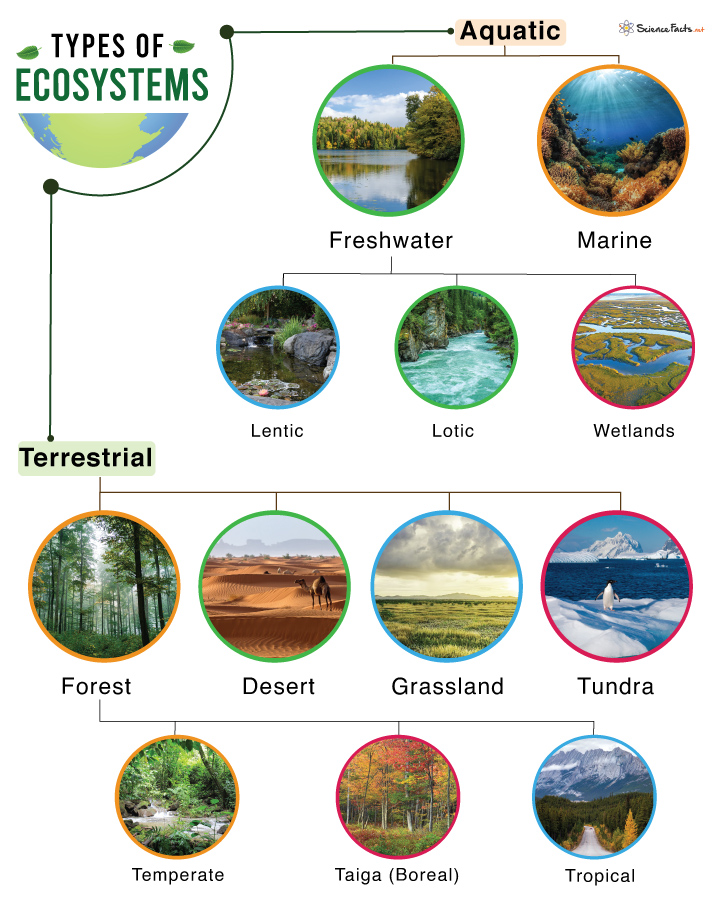Types of Ecosystems
An ecosystem constitutes all the living and non-living things and the environment around that community. There is a specific area for different ecosystems where the living things interact with each other and the environment.
Broadly, there are two types of ecosystems on Earth – terrestrial and aquatic. However, there are different types of terrestrial and aquatic ecosystems.
Terrestrial Ecosystems
Terrestrial ecosystems are land ecosystems. Based on their geographic location, the different types of terrestrial ecosystems are:
1. Forest Ecosystems
A forest ecosystem consists of many flora, fauna, and microorganisms coexisting in an area and interacting with abiotic factors like sunlight, soil, air, and water. Thus, the forest ecosystem provides shelter to many plants and animal species and is the primary carbon sink of the Earth.
Based on their climatic conditions, there are different types of forest ecosystems:
a) Tropical Forest Ecosystems
High temperatures, humidity, and rainfall throughout the year are typical of tropical forest ecosystems. It has a large diversity of vegetation due to favorable growth conditions.
South America’s Amazon rainforest is the largest tropical rainforest in the world.
b) Temperate Forest Ecosystems
High levels of precipitation are found in the temperate forest ecosystem. Depending on their location, temperate forests can be composed chiefly of deciduous or coniferous trees.
The temperate forest has a high diversity of flora and fauna. In addition, lichen and mosses are also commonly found in such ecosystems.
c) Taiga or Boreal Ecosystems
The taiga is the third largest forest ecosystem, including forests in the Northern Hemisphere’s subarctic region. They experience low temperatures all year long, with long winters and very short summers.
These ecosystems mainly consist of coniferous or evergreen trees. While large mammals like moose and caribou are most abundant, many bears and Siberian tigers are also found to exist.
2. Grassland Ecosystem
In grassland ecosystems, the vegetation is dominated by grasses and herbaceous plants. However, some shrubs are also found. It is a perfect setup for grazing and herbivorous animals like cows, buffalos, and deer.
The climate is pleasant and is similar to semi-arid regions. Like forest ecosystems, grassland ecosystems are also found in tropical and temperate regions. Savanna grasslands are a typical example of a grassland ecosystem.
3. Tundra Ecosystem
Tundra ecosystems are frigid regions where the temperature often reaches sub-zero with a scarcity of rainfall. Most of the year, the area is covered with snow, making survival challenging. Tundra ecosystems are found in the Arctic mountainous regions.
The biodiversity of flora and fauna in the tundra ecosystem is less than in the forest or grassland ecosystems. Typical plant species include low-lying grasses, plants, and shrubs, which can withstand harsh climates. During summer, the ecosystem bursts with life as pollination occurs, plants bloom, and animals give birth to their young ones.
4. Desert Ecosystem
Desert ecosystems are arid regions that receive scanty or low yearly rainfall. Very few plants and animals live in such ecosystems due to their arid environments.
However, not all deserts are hot. There are cold deserts in the Arctic that are cold and dry at the same time.
Aquatic Ecosystem
Aquatic ecosystems are ecosystems containing water bodies. There are two broad types of aquatic ecosystems:
1. Marine Ecosystem
The marine ecosystem covers almost 70% of the Earth’s surface and thus is the most extensive ecosystem on Earth. It includes all seas and oceans.
Water in the marine ecosystem contains dissolved salts and minerals. Some common organisms in such ecosystems are sharks, cephalopods, brown algae, echinoderm, corals, and dinoflagellates.
Within the marine ecosystems are coral reefs. They inhabit diverse fish populations and many aquatic plant species.
2. Freshwater Ecosystem
Freshwater ecosystems cover less geographic area than marine ecosystems occupying almost 0.8% of the Earth’s surface. These systems comprise lakes, rivers, streams, and springs; they are pretty diverse and support a variety of animals, plants, fungi, protists, and prokaryotes.
The three types of freshwater ecosystems are:
a) Lentic Ecosystem
Lentic ecosystems are freshwater ecosystems with slow-moving water. Pools, ponds, and lakes are examples of lentic water bodies on Earth.
b) Lotic Ecosystem
Lotic ecosystems are freshwater ecosystems with fast-moving water, such as streams and lakes.
c) Wetlands
Wetlands are areas where the soil is saturated or inundated permanently or for a short period. It is a type of shoreline ecosystem found on the shores of lakes, rivers, and even seas.
The water in wetlands is freshwater, brackish, or saltwater. They are relatively small than lentic and lotic ecosystems in the area. The water depth, temperature, and availability of nutrients determine flora and fauna of the wetlands.
-
References
Article was last reviewed on Thursday, May 11, 2023




